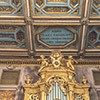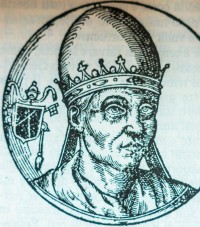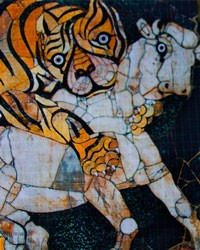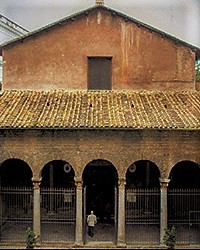
Interior of the Church of Sant'Agata dei Goti

St. Agatha, Church of Sant'Agata dei Goti, bas-relief showing the patron of the temple - above the entrance portal

Façade of the Church of Sant'Agata dei Goti,via Mazzarino

Church of Sant'Agata dei Goti, arcades of the inner courtyard

Church of Sant'Agata dei Goti, courtyard in front of the main facade of the temple

Church of Sant'Agata dei Goti, a fountain in the courtyard of the temple

Church of Sant'Agata dei Goti, internal courtyard

Interior of the church of Sant'Agata dei Goti, apse with frescoes depicting Gloria St. Agates, late 16th century

Church of Sant'Agata dei Goti, cyborium in the apse

Christ surrounded by the apostles - reconstruction of the fifth-century apse mosaic, Rycymer's foundation, church of Sant'Agata dei Goti

Interior of the Church of Sant'Agata dei Goti

Interior of the Church of Sant'Agata dei Goti

Interior of the Church of Sant'Agata dei Goti

Reconstruction of marble decorations decorating the walls of the temple in the 6th century, the church of Sant'Agata dei Goti

Figure of the patron of the church, 18th century, church of Sant'Agata dei Goti

Tombstone of Cardinal Juan Francisco Marco y Catalán, 19th century, church of Sant'Agata dei Goti
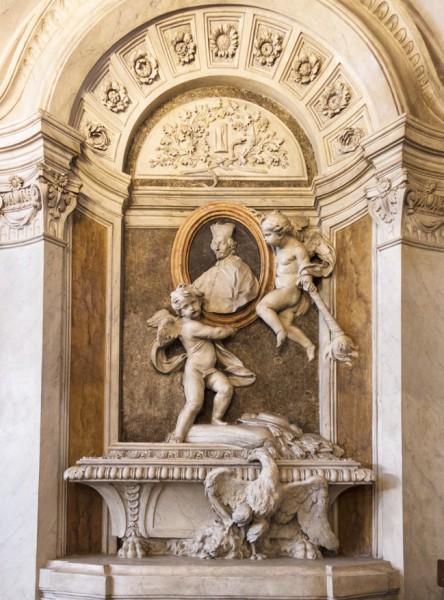
The tombstone of Cardinal Carl Bichi, Carlo de Dominicis, church of Sant'Agata dei Goti
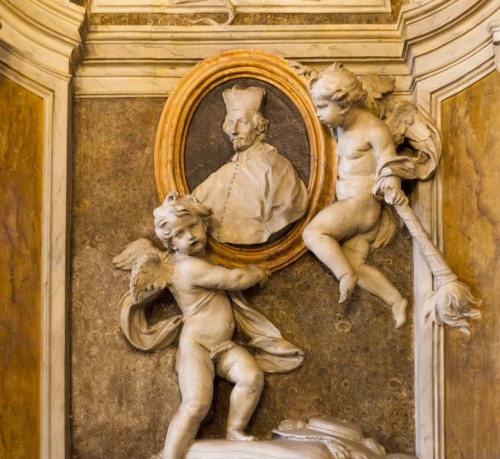
The tombstone of Cardinal Carl Bichi, fragment, Carlo de Dominicis

The Martyrdom of St.Agatha, Paolo Perugini, one of the frescoes decorating the interior of the church of Sant'Agata dei Goti

Saint Agatha, Paolo Perugini, fresco in the interior of the church of Sant'Agata dei Goti

Medallions with images of saints of Irish origin, the interior of the church of Sant'Agata dei Goti

Interior of the church of Sant'Agata dei Goti, view of decorations with the story of the life and death of Saint

Choir and ceiling fragment with dedication to Cardinal Francesco Barberini

Church of Sant'Agata dei Goti, ceiling

Entrance to the church of Sant'Agata dei Goti
Although this church is found in the very center of Rome, literally only a few steps away from the busy via Nazionale, it remains almost unknown and is rarely visited. Its Rococo façade also does not show, that right behind it, below the level of the street, there is a building which can transport us to the distant times of late antiquity, at the same time bringing into light the faded traces of one of the old branches of Christianity, over which heated disputes occurred for centuries.
Although this church is found in the very center of Rome, literally only a few steps away from the busy via Nazionale, it remains almost unknown and is rarely visited. Its Rococo façade also does not show, that right behind it, below the level of the street, there is a building which can transport us to the distant times of late antiquity, at the same time bringing into light the faded traces of one of the old branches of Christianity, over which heated disputes occurred for centuries.
Exactly when the church was created, we do not know. Some researchers claim that it was as early as the IV century. However, definite information regarding the building did not appear until the year 460 when its apse was decorated with a mosaic funded by an influential Western Roman patrician, consul and military leader of Germanic roots – Ricimer. This information was found on an inscription located below. The decorations depicted Christ seated upon the globe, his disciples dressed in togas on either side, with St. Peter with keys and St. Paul with a scroll of laws at their head. Presently these mosaics no longer exist. Luckily they were described and copied, that is why we know about the foundation of this Romanized “barbarian”, who not only held power in the city on the Tiber, but also decided who would sit upon the throne of the Western Roman Empire. The church itself was designated for the commune of the Ostrogoths – faithful of Arianism - who accompanied Ricimer and were stationed in the city. It is therefore, a relic of presently forgotten branch of Christianity, which ultimately was deemed as heretical. The church was called ecclesia Gotharum and was dedicated to Christ the Savior. At the end of the VI century Arianism was completely removed from the city, which was symbolized by a second consecration of the church by Pope Gregory the Great and its transfer to the Roman Catholic Church. It was then that Saint Agatha (Sant’Agate in Subura), whose relics were brought from Sicily, became its new patron. It was on Sicily that the martyrdom of the young virgin took place in the middle of the III century, at least according to a legend. Why was she named as the patron? The reason was, that she was to aid in the defeat of the Goths during the so called Gothic Wars fought in the middle of the VI century.
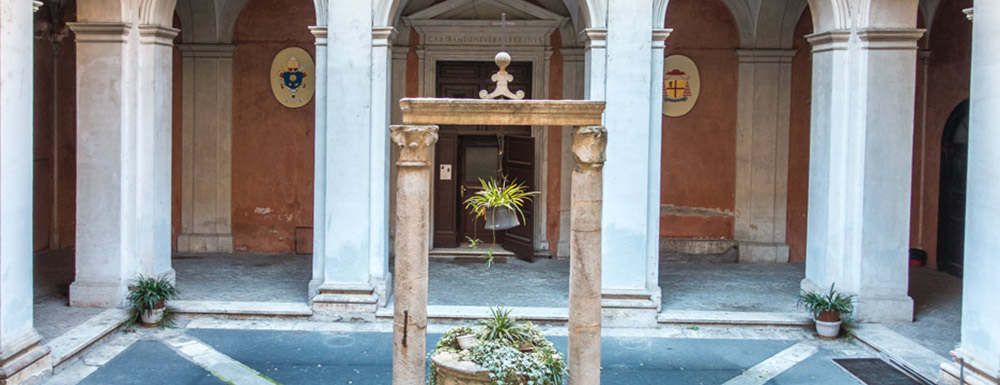
Seen from the via Mazzarino, the slightly concave façade created in the middle of the XVIII century is decorated with stuccos depicting Saint Agatha with a tray on which she is carrying her breasts. She is surrounded by two cherubs. At the top we will notice palms of martyrdom as well as a crown – the attributes of virgin martyrs. A gate leads us onto the courtyard found below the level of the street with surrounding arcades decorated with pilasters. We descend to this level via truly palatial two-way steps. In the middle of the courtyard there is a moss-covered fountain (XVI century). This constantly damp and shaded spot immediately attracts our attention, especially since we can find remains of decorations dating all the way back to the V-IX centuries, discovered during archeological works. Monastery buildings, or more appropriately what is left of them, since most of them were destroyed during works on the Banca d’Italia building neighboring the church, stretch around the courtyard.

Passing through the church door, we find ourselves in a dark interior, which had in the past only been illuminated by the rays of the sun, descending through the windows situated above the row of the arcades. Two of these windows, presently walled up were found in a broad apse. The triple-nave enterance, typical for early-Christian architecture is divided into naves by two rows of granite columns (most likely part of some ancient pagan temple in the past) with Ionian capitols, which support the arcades. It survived thus for subsequent centuries. In time monastery buildings were added to the church, designated for the Benedictines who were brought here (XI-XII century), but who did not stay very long. In the following centuries, the building was transferred from one hands to the other. At this time a ciborium was placed in the apse, adorned with a Cosmati-style decoration (XII/XIII century), which was then reconstructed in the XX century. Such was also the case with the floor. It is from the XX century, but it contains mosaic fragments from the XV century. In the XVI century the aforementioned apse mosaic was torn down and replaced with frescoes depicting the Glory of St. Agatha (1599?). It was completed by an artist named Giacomo Rocca.
Although attempts were made to restore the church which had been deteriorating, it was not until the thirties of the XVII century when it was thoroughly modernized, while the interior was made more in the spirit of the Baroque; this occurred thanks to two representatives of the Barberini family – cardinals Antonio and Francesco. It was due to them, that the church initially topped with an open roof truss, was covered with a flat ceiling. Paintings were created between the windows which tell the story of the martyrdom of St. Agatha, who despite numerous tortures did not renounce her faith in Christ. According to a rather perverse legend, subjugated to tortures, such us the severing of her breasts, she was killed by pagan oppressors during the persecutions of Emperor Decius. This scene along with others, connected with the last days of the life of the saint, was created by Paolo Perugino.
The church is not filled with particularly valuable artistic objects, however it amazes with its ancient interior (restored in the thirties of the XX century), yet even here interesting items can be discovered. One of these is the Altar of St. Agatha (in the right nave, immediately next to the apse), funded at the beginning of the XVI century. Within, there is a wooden, gilded statue of the saint (XVIII century), holding a small tray with her breasts in front of her. In the right nave there is also the tombstone of Cardinal Juan Francisco Marco y Catalánza in a style reminiscent of early Renaissance, although in truth it is a creation from the middle of the XIX century. In the left nave (right at the enterance) we are attracted to an impressive, made in stucco, Rococo tombstone of Cardinal Carlo Bichi, completed by Carlo de Dominicis.
The tondi found between the arcades remind us of Irish saints, a souvenir left by monks (Irish College), who had for ages been the caretakers of the church. Presently it belongs to the Congregation of the Sacred Stigmata (Stigmatines).

In order to fully appreciate the church it must be seen from the rear – from the via Panisperna. From here a view of a broad apse stretches out, and it is this apse - next to the original body of the church as well as the columns – which is a testimony to the ancient roots of this building.
















































